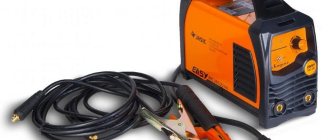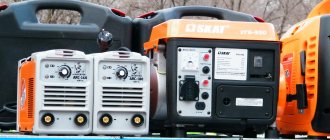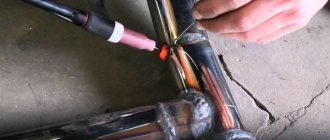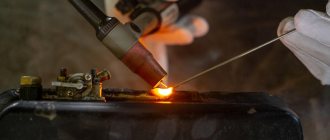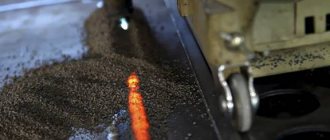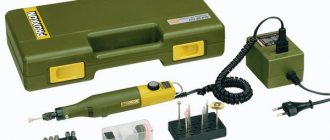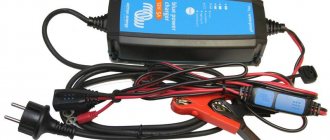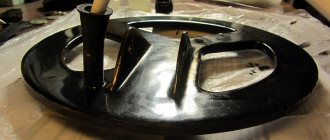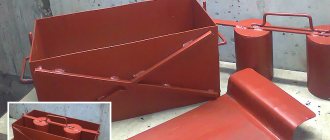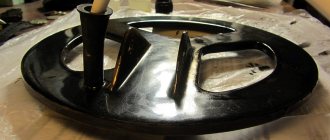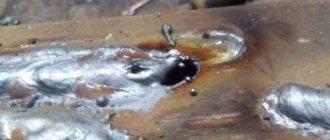Radio circuits. — Welding machine using powerful thyristors
materials in category
The proposed device is a direct current regulator, and since its adjustment range is very wide and uses powerful thyristors, it can be used both as a powerful charger and as a welding machine.
Diagram of a thyristor welding machine
A graph explaining the operation of a power unit made according to a single-phase bridge asymmetrical circuit (U2 is the voltage coming from the secondary winding of the welding transformer, alpha is the opening phase of the thyristor, t is time).
The regulator can be connected to any welding transformer with a secondary winding voltage U2=50…90V. The proposed design is very compact. The overall dimensions do not exceed the dimensions of a conventional unregulated bridge rectifier for DC welding. The regulator circuit consists of two blocks: control A and power B. Moreover, the first is nothing more than a phase-pulse generator. It is made on the basis of an analogue of a unijunction transistor, assembled from two semiconductor devices of npn and pnp types. Using variable resistor R2, the direct current of the structure is regulated. Depending on the position of the R2 slider, capacitor C1 is charged here to 6.9 V at different rates. When this voltage is exceeded, the transistors open sharply. And C1 begins to discharge through them and the winding of the pulse transformer T1. The thyristor, to the anode of which a positive half-wave approaches (the pulse is transmitted through the secondary windings), opens.
As a pulse one, you can use industrial three-winding TI-3, TI-4, TI-5 with a transformation ratio of 1:1:1. And not only these types. For example, good results are obtained by using two two-winding transformers TI-1 with a series connection of the primary windings. Moreover, all of the above types of TIs make it possible to isolate the pulse generator from the control electrodes of the thyristors.
There is only one “but”. The pulse power in the secondary windings of the TI is not sufficient to turn on the corresponding thyristors in the second (see diagram), power block B. An elementary way out of this “conflict” situation was found. To turn on the powerful ones, low-power thyristors with high sensitivity to the control electrode are used.
Power block B is made according to a single-phase bridge asymmetrical circuit. That is, the thyristors work here in one phase. And the arms on VD6 and VD7 work as a buffer diode during welding.
Installation? It can also be made mounted, based directly on the pulse transformer and other relatively “large-sized” circuit elements. Moreover, the radio components connected to this design are, as they say, minimum-minimorum.
The device starts working immediately.
Modeler-designer 1994 No. 9. A. CHERNOV, Saratov
radio-uchebnik.ru
ON THYRISTOR
I propose a schematic diagram of a welding machine using a high-speed thyristor. The circuit is a copy of the industrial welding machine "Electron-125". The power is sufficient to cook with an electrode with a diameter of 3 mm, in most cases this is sufficient.
Range of regulation of welding current, A
Open circuit voltage, V………………….not more than 90.
Efficiency factor, %……….not less than 60.
Conversion frequency is about 4 kHz. The output power is regulated by changing the frequency of the generator, made on an analogue of the unijunction transistor VT1 and VT2. I didn't make this diagram myself. It was made by a friend of mine. The circuit is quite functional, but it has its own small problems: the circuit emits an unpleasant squeaking sound, and in idle mode it often clicks relay K2, which is triggered when U exceeds the idle speed at the output.
Power Electronics
kuzikovs wrote:
Yes, it’s too early to describe it actually
I think it’s just time! There’s less chance of mistakes!
kuzikovs wrote:
T2 8-line w-shaped gap what remained from the previous circuit 0.2 mm, if it is necessary at all, I still don’t understand, I protected the turns relative to the inductance using the formulas given by the author,
Yeah, and right here! Take your time, now I’ll find information on this issue from Tiran, who had problems with these cores, and then he found the reason and successfully did the same for them! You see, the description is right on time! I copy everything and after a while I will find and post a copy, the number of turns is specifically indicated there.
kuzikovs wrote:
He also left the protective nichrome and saved the shooting ranges from death, he also left a snubber chain parallel to the shooting ranges and removed the reverse diode.
Everything seems to be fine here, but it seems to me better to install reverse diodes, I agree with *Antek*, and even with the generator connected in this way, the circuit may not be predictable!?
Here *cuzikovs* found the necessary information for you! Good luck!
valvol.ru
How to make a homemade welding inverter using thyristors?
- Date: 08/17/2015
- Rating: 35
A homemade welding inverter is made using transistors and thyristors. Simple transistor devices are not reliable enough. Analogues with thyristors are able to withstand output short circuits until the fuse trips (in the absence of damage). An inverter based on thyristors heats up less during operation than a welding inverter based on transistors. The advantage of homemade devices is their simple design and the general availability of the necessary parts and materials.
Scheme of an inverter welding source.
{advertisement1}
Tool making instructions
Experts advise first familiarizing yourself with the equipment diagram. One of the main parts is a 6 mm duralumin plate, to which it is necessary to attach conductors with wires (without thermal insulation) that give off heat. To assemble a thyristor-based welding inverter, you will need the following tools and materials:
- radiator from a car;
- wires;
- seals;
- diodes;
- duralumin plate.
The radiator from the car will act as a fan, blowing air through the throttle and diodes. The choke is made of 6 copper cores and is pressed to the base using a seal. The diodes must be pressed to the base of the welding inverter circuit, attaching stabilizers and seals.
Table of required technical characteristics for a welding inverter.
You will need a transformer with a cross section of 2 mm and no insulation. The use of insulated cable is allowed. There are 4 wires in the conductor bundle. Insulating materials - electrical tape or fluoroplastic tape. It is necessary to leave a gap between the insulation layers (to cool the transformer).
The conductors must be spread apart for the welding inverter to function without failure. Then the power bridge is installed on the transistor. Use copper wire with a cross section of 2 mm. It must be wrapped with 2-3 layers of sewing thread. The conductor is fixed with insulating heels, to which the load from the transistors is transferred. A homemade welding inverter made according to this scheme is capable of working for a long time without interruption.
Manufacturing such equipment according to Negulyaev’s scheme requires pressing the transistors to the radiator. They are installed using duralumin plates and secured with small screws. Power bridges blown by fans are insulated so that there is no need to connect transistors to the bridges and radiator. Experts recommend taking into account the resonant voltage. The secondary winding (if necessary) is output to the power receiver or to the cylinders. The energy from the receiver goes to the cores.
Pulse equipment
Tools for making welding equipment.
The manufacture of high-power equipment requires winding across the entire width of the frame (to increase the transformer’s resistance to external forces and voltage surges). To assemble this device you will need:
- seals;
- converter;
- copper tin;
- knife;
- insulating tape.
It is necessary to make several layers of the secondary winding of the device, and wind the inductor on a ferrite core.
The device will be cooled using a radiator from a computer, which corresponds to the equipment being manufactured in terms of electricity and power consumption.
It is undesirable to use aluminum wires for a generator because of their instability to alternating current fluctuations.
{advertisement2}
The operation of the unit depends on the following indicators:
- thickness of the wire used;
- use of alternating or direct current;
- transmission capacity from 30 to 160 A.
You can set up a homemade welding machine with the help of professionals or yourself. The generator must be connected to the network. The unit will begin to make loud noises when current is transferred. The resistor must be closed by connecting the relay after charging the capacitors. Transmittance is determined using a multimeter. The device needs to be switched to ammeter mode and the frequency of pulses is determined. The indicator should be 44%.
The generator is tested using an optocoupler and an amplifier. The average amplitude value for low-power devices is 15 V. Then it is necessary to check the power bridge assembly by supplying 16 V power to the device. At idle, a conversion of up to 100 mA is recorded. Measurements will not be accurate if these recommendations are not followed.
https://moyasvarka.ru/youtu.be/LvIyLUOzS64
The operation of the generator is checked with an oscilloscope. The pulses emanating from the windings must match. The transformer is controlled by capacitor control. It is necessary to increase the throughput level to 200 V, connect the inverter to an oscilloscope and monitor the shape of the incoming signal coming from the emitter collector.
moyasvarka.ru
Thyristor control circuits in resistance welding
It is almost impossible to imagine the assembly of metal structures without electric welding. I propose to consider the circuit of a welding transformer with electronic current control. It has no moving parts that require high quality assembly and are subject to vibration. The control unit allows you to smoothly regulate the welding current by turning the potentiometer knob. At the same time, the arc burns stably throughout the entire range of changes.Technical characteristics of a welding transformer with electronic current regulation:
Supply voltage, V 220
Welding current control limits, A 45 - 140
Open circuit voltage of power arc, V 42
Pilot arc no-load voltage, V 87
Make-up current, A 15
Figure 1 shows the electrical circuit of the welding machine. It includes: welding transformer T3; power rectifier using thyristors VS3, VS4; rectifier for powering the pilot arc using diodes VD6 - VD9, smoothing choke L1; control unit for power thyristors on transistors VT1 - VT5.
Rice. 1. Schematic diagram of a welding machine with electronic current control and power supply from a 220 V mains voltage
The main arc is powered by a rectifier using thyristors VS3, VS4; the value of the welding current changes by changing the switching angle of the thyristors.
When the power thyristors are closed, the welding arc current is provided by the feed circuit on diodes VD6 - VD9 and inductor L1.
The power rectifier has a falling external characteristic. The pilot arc rectifier has a steep external characteristic, and due to the inductor L1, a continuous current is maintained in the arc circuit, which ensures stable arc burning and does not allow the electrode coating to crumble.
The control circuit consists of a power source on transformer T1, a rectifier on diodes VD1, a synchronization circuit on transistors VT1 and VT5, a phase-shifting device on transistors VT3, VT4, a comparison unit on transistor VT2, a welding current meter circuit on current transformer T4, a control circuit for power thyristors on thyristors VS1 and VS2.
The synchronization circuit on transistors VT1, VT5 is designed to discharge capacitance C3 of the phase-shifting device at the beginning of each half-cycle of the network supply voltage. At the moment when the network voltage is 0, at the base of the transistor VT1 there will be 0 (it is closed), and VT5 is open and C3 is discharged; in all other cases, VT5 is closed.
At the beginning of each half-cycle of the supply voltage, capacitor C3 is charged through VT2 and R8; at the moment when the voltage at C3 is equal to the voltage at the base of the transistor VT3, it opens, VT4 and C3 are discharged to the I winding of the pulse transformer T2. From windings II and III, a current pulse opens the thyristor VS1 or VS2 (the thyristor opens, at the anode of which there is a positive half-wave voltage). The control current from winding III or IV of transformer T1 through an open thyristor VS1 or VS2 is supplied to the power thyristor VS3 or VS4. Of these thyristors, the one through whose control electrode the control current flows opens. The latter is limited by resistors R14 or R15. The welding arc current flows through the open thyristor VS3 (VS4), it is measured by current transformer T4 and through the feedback circuit VD5, R17, C4, R18, R20, R7 is supplied to the comparison circuit on transistor VT2. The voltage from the resistor R20 motor is compared with the voltage at point “A” of the comparison circuit. Transistor VT2 changes its internal resistance (it operates in active mode) depending on the voltage difference at point “A” and across the resistor R20. If the current through the welding arc has increased more than that set by the control unit, the internal resistance VT2 increases, capacitor C1 charges more slowly, the switching angle of the power thyristors increases and, therefore, the current through the welding arc decreases.
If the welding current decreases below that set by the control unit, reverse processes occur: the switching angle of the power thyristors decreases and, consequently, the arc current increases. In this way, the welding current is regulated.
The welding arc current is set from the control panel by turning the resistor R20 slider. As the arc burns, the gap between the end of the electrode and the welding product changes, therefore, the voltage on the arc also changes. In some cases (with a large gap) it becomes greater than the open circuit voltage of the power rectifier, and then the arc begins to be powered by the pilot arc rectifier, and the power thyristors close. If the length of the welding arc decreases, the power thyristors will open again, since control current flows through the control electrode of the thyristor during the entire half-cycle.
Transformer T1 can be of any power, but not less than 20 W, primary winding I - 220 volts, winding II - 24 volts, wire diameter not less than 0.13 mm, windings III and IV - 12 volts, wire diameter not less than 0.25 mm.
Transformer T2 is wound on a K20x10x5 core made of 2000NM ferrite. Its windings I, II, III are each 50 turns of PEV-1 wire with a diameter of 0.2 mm.
The core of the T3 transformer is made of electrical cold-rolled steel grade 3404 with a thickness of 0.35 mm (dimensions are shown in Fig. 2). Winding I - 162 turns: two sections of 81 turns of copper wire with a cross section of 8 mm2 (2x4 mm). Each winding II and III has 32 turns: it consists of two sections of 16 turns of copper wire with a cross-section of 15 mm2 (3×5 mm). Windings I, II, III have fiberglass insulation impregnated with heat-resistant varnish. Winding IV, V - 93 turns of enameled wire with a diameter of 1.7 mm.
Rice. 2. Welding transformer T3 (electrical (a) and physical (b) layout of windings on the magnetic core):
1 — winding I (two sections of 81 turns of copper wire with a cross-section of 8 mm2); 2.3 - windings II and III (each of two sections of 16 turns of copper wire with a cross-section of 15 mm2); 4.7 - windings V and IV (93 turns of enameled wire with a diameter of 1.7); 5 - core (cold-rolled steel grade 3404, sheet s0.35); 6 - magnetic shunt.
As a current transformer T4, a core from a current transformer TK 200, 100/5 was taken. It has two primary
windings of one turn with a cross section of 15 mm2. As a wire, you can use a welding cable or other stranded wire in insulation. The secondary winding is 400 turns of enamel wire with a diameter of 0.5 mm. It is wound onto the frame from the old secondary winding.
Throttle core L1 is made of electrical steel; the cross-section of the magnetic core (passing through the winding) is at least 12 cm2 with a non-magnetic gap of 1 mm. The number of turns of enamel wire with a diameter of 2.24 mm is 68.
The circuit is not critical to radio elements, with the exception of VT3 and VT4 (a pair of these transistors should be an analogue of a dinistor). Resistor R20 must have a knob to regulate the welding current. Resistor R16 is PEV 10. Resistor R15 (R14) is assembled from three parallel-connected one-watt resistors of 47 Ohms each.
Debugging of the welding transformer is carried out block by block. First, it is assembled and connected to the network through a fuse of at least 30 A. Then the voltage on the secondary windings is checked: on II and III - up to 45 volts, and they must be turned on according to; on windings IV and V - up to 90 volts (switching on is also according to). The single-turn windings of current transformer T4 are connected in series with the power thyristors so that it operates in magnetization reversal mode.
After assembling the control unit, check the pulses at the T2 output and the operation of the synchronization circuit. For ease of testing, instead of transistor VT2 in parallel with R9, you should install a variable resistance of 20 kOhm and, by changing its value, check the change in the switching angle of the dinistor analogue. Then the whole circuit is assembled. An ammeter with a total deflection current of 150 - 200 A is placed in the welding arc circuit. When welding metal, it is necessary to adjust the resistor R18 so that when the handle of the variable resistor R20 is turned, the welding current changes from 45 to 140 A.
Power thyristors are mounted on standard radiators; diodes VD6 - VD9 are installed on four radiators with an area of 30 cm2 each.
Electronic control of the welding current is very convenient during welding work, especially in different spatial positions of the welding seam.
Modeler-constructor 2005 No. 1
